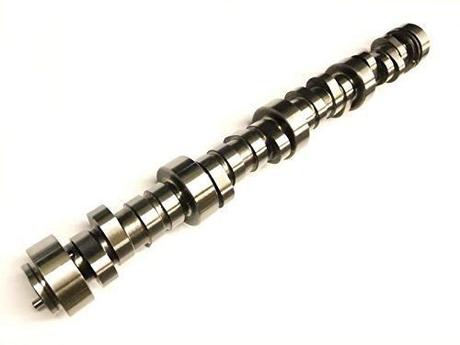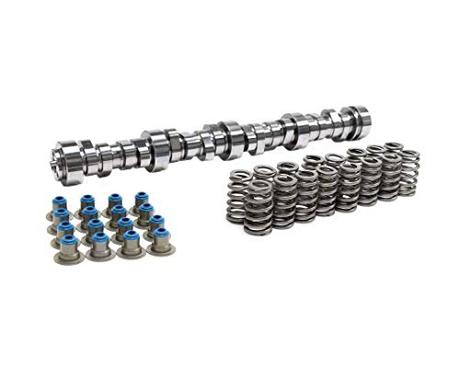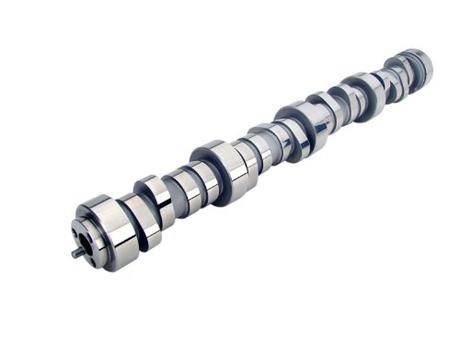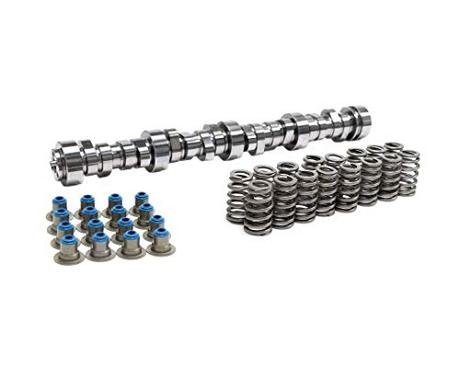We've collated the best camshafts for 4.8 Silverado but first there are a few words about camshafts.
Now, if you are not a professional or enthusiast, the term camshaft won't mean much to you, and it also has other names such as followers or tappets. Essentially, Camshafts are a precision machined bar of metal that makes direct contact with the camshaft lobe. There are four different categories of camshaft lifters: mechanical flat-tappet, hydraulic flat-tappet, roller hydraulic, and roller mechanical.
Top-Rated Cam for 4.8 Silverado List:
Still confused, of course, you are, so here goes. One of the ways you can change an engines power performance is by changing the amount of fuel and air in the valve, this means you need to lift the valve mount higher than it was originally designed for, or what is termed OE (stock), original engine (purpose). The stock items come with precise dimensions for stock performance, which is the engine performance you get to form a brand-new car with no upgrades.
Replacing a stock camshaft with an aftermarket camshaft will alter the performance of the engine by changing the lift ratio of the valve. Upgraded cams also change the time of the lift, which allows even more fuel and air to intake into the valve.
Bottom line, I added a camshaft 101 at the end of this guide, so now we will dive into the 5-best cam for 4.8L Silverado applications.
Best Cam for 4.8 Silverado Reviews:
Melling has engineered comprehensive OE replacement parts including camshafts. These parts are machined to high tolerance and will only replace very specific models. This model will match all stock performance models and is not an aftermarket upgrade.
Specifications- Cam Style: Hydraulic roller tappet
- Intake Duration: 193
- Exhaust Duration at .050" Lift: 193
- Intake Duration at .050" Lift: 193
- Lifter Type: Roller
- Intake Valve Lift with Factory Rocker Arm Ratio: 0.482"
- Exhaust Valve Lift with Factory Rocker Arm Ratio: 0.482"
- Valve Lift with Factory Rocker Arm Ratio: 0.482" int./0.482" exh.
- Lobe Separation (degrees: 114o
- This is a replacement for OE# 12625437.

COMP Cams XFI Xtreme truck camshafts are a great upgrade to any stock item, and this is no exception. These are machined to improve throttle response in fuel injection engines and delivers a better mid and upper RPM power. When you upgrade your camshaft with a COMP Cams XFI part, you should consider upgrading the valvetrain equipment for a harmonized and optimized performance.
Specifications- Cam Style: Hydraulic roller tappet
- Basic Operating RPM Range: 800-5,000
- Intake Duration at 050" Lift: 206
- Exhaust Duration at 050" Lift: 212
- Duration at 050" Lift: 206 int./212 exh.
- Intake Valve Lift with Factory Rocker Arm Ratio: 0.513"
- Exhaust Valve Lift with Factory Rocker Arm Ratio: 0.520"
- Valve Lift with Factory Rocker Arm Ratio: 0.513" int./0.520" exh.
- Lobe Separation (degrees: 115o
- Camshaft Gear Attachment: 3-bolt
- You cannot use stock springs with this upgrade

When it comes to aftermarket camshaft upgrades, Brian Tooley Racing is considered to be a precision engineering leader in the field. They produce a number of focused parts, and this model #32430112 delivers improved performance, making this an extremely attractive aftermarket cam.
Specifications- Cam Style: Hydraulic roller
- Intake Duration at 050" Lift: 224
- Exhaust Duration at 050" Lift: 230
- Intake Valve Lift with Factory Rocker Arm Ratio: 0.553"
- Exhaust Valve Lift with Factory Rocker Arm Ratio: 0.547"
- Lobe Separation (degrees: 111o (+2)
- Camshaft Gear Attachment: 3-bolt
- Requires a 3000-3200 converter
- Length 25" x Height 2.75" x Width: 2.75"
- Weight: 10.1360Kgs

This is the stage II model aftermarket camshaft upgrade from Michigan Motorsports. Brian Tooley Racing is considered to be a precision engineering leader in the field. They produce a number of focused parts, and this model #31824133 delivers improved performance, making this an extremely attractive aftermarket cam.
Specifications- Cam Style: Naturally Aspirated Hydraulic roller
- Intake Duration at 050" Lift: 218
- Exhaust Duration at 050" Lift: 224
- Intake Valve Lift with Factory Rocker Arm Ratio: 0.553"
- Exhaust Valve Lift with Factory Rocker Arm Ratio: 0.553"
- Lobe Separation (degrees: 113o (+3)
- Camshaft Gear Attachment: 3-bolt
- Requires a 3000-3200 converter
- Length 25" x Height 2.75" x Width: 2.75"
- Weight: 10.790Kgs

This model of COMP Cams XFI RPM High Lift was designed for overall performance improvement. It is an aftermarket cam that increases your engines horsepower and torque as well as extending your RPM range.
Specifications- Cam Style: Hydraulic roller tappet
- Basic Operating RPM Range: 1,400-6,700
- Intake Duration at 050" Lift: 212
- Exhaust Duration at 050" Lift: 218
- Duration at 050" Lift: 212 int./218 exh.
- Intake Valve Lift with Factory Rocker Arm Ratio: 0.558"
- Exhaust Valve Lift with Factory Rocker Arm Ratio: 0.563"
- Valve Lift with Factory Rocker Arm Ratio: 0.558" int./0.563" exh.
- Lobe Separation (degrees: 115o
- Camshaft Gear Attachment: 3-bolt
- You cannot use 7-stock springs with this model
There are five types of camshafts; each one is machined to deliver a different result, although the OEM replacements tend to deliver the stock performance levels within a high level of confidence. The models have been arranged from the simplest to the most aggressive.
Hydraulic RollerApplication: These are either OEM replacement parts or aftermarket parts for slight increases in performance. They are used for mild street performance to mild race advantage. This style is more expensive than flat tappet lifters.
Pros: Modern, aggressive roller profiles, reduced friction, low maintenance, reduced valve train noise, they deliver more power than standard hydraulic flat tappet camshafts
Cons: Increased cost, limited rpm range
Retro-Fit Hydraulic RollerApplication: These are used for mild street performance to mild race advantage. The difference between these and Hydraulic rollers are that these parts come with a specialized base circle for taller hydraulic roller lifters in factory equipped tappet valve stock blocks.
Pros: These are modern parts with aggressive roller profiles. They reduce friction and are therefore low maintenance. Another advantage is their reduced valve train noise, and they deliver more power than conventional hydraulic flat tappet camshafts
Cons: They are more expensive and have a limited rpm range due to profile limitations
Hydraulic Fit Flat TappetApplication: These are used for mild street performance to mild race. Hydraulic flat tappet camshafts/lifters are the OEM standard, and they are pre-loaded at initial start-up, and their maintenance is very low. The downside in flat tappet lifters is that they can only be used once must be replaced when wear patterns form from direct contact of the cam with the lifter base.
Pros: These parts require minimal maintenance, and produce little or no valve train noise. They are also budget friendly.
Cons: They have an issue with long-term wear, and provide limited rpm range due to lobe profile limitations
Mechanical Flat TappetApplications: These models are the original race engine lifter; solid flat tappet camshafts and they provide an aggressive street performance as well as racing profile. They enable the engine to increase its RPM and are used for moderate street performance to serious race requirements.
Pros: These parts increase the engines RPM and deliver an optimized aggressive performance to cost ratio that exceeds the hydraulic flat tappet models.
Cons: They suffer from long-term wear and require frequent valve adjustment.
Solid Mechanical RollerApplication: These models provide the highest levels of performance. Solid rollers will deliver high-performance street with optimized and extreme racing applications. These parts are machined with aggressive camshaft lobe profiles, and they are engineered to withstand extreme valve spring pressures. These are used for serious street performance and for all all-out racing.
Pros: These models deliver maximum performance with reduced friction and come with the most aggressive and optimized profiles.
Cons: Obviously optimization comes at a cost, so these are the most expensive, and they require frequent calibration. They are not suited for general driving conditions at low RPM.
[ratings]
More Silverado Reviews - See our best:

